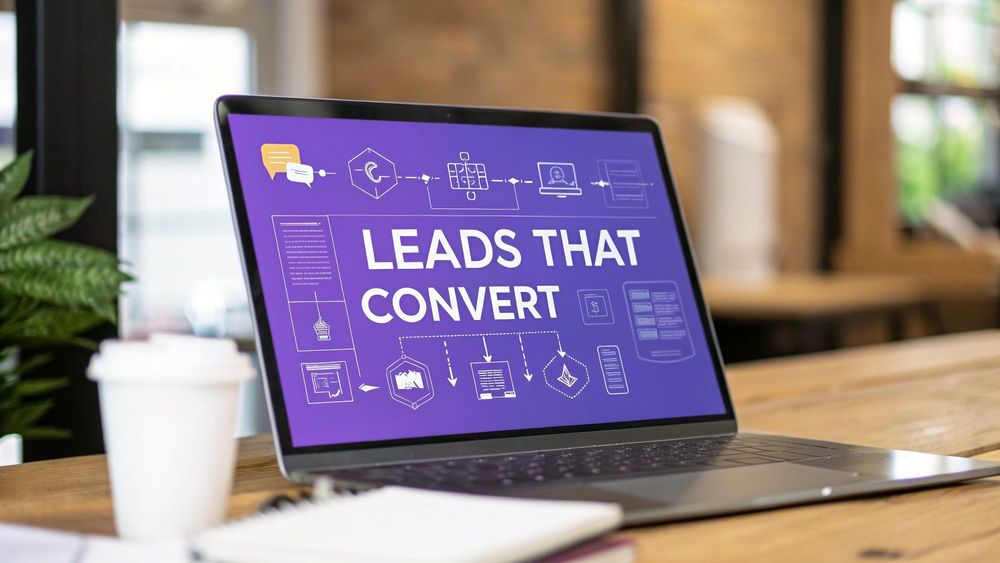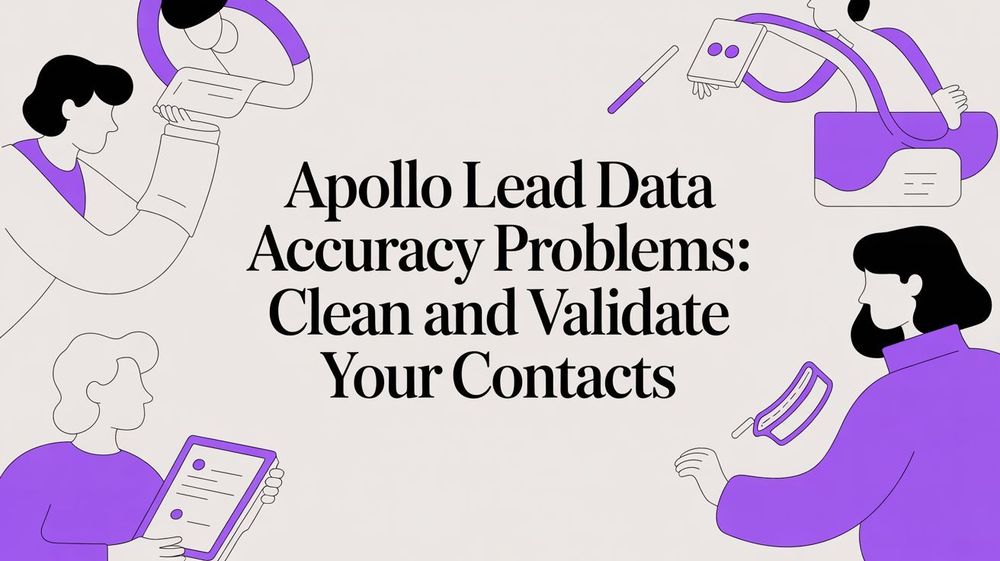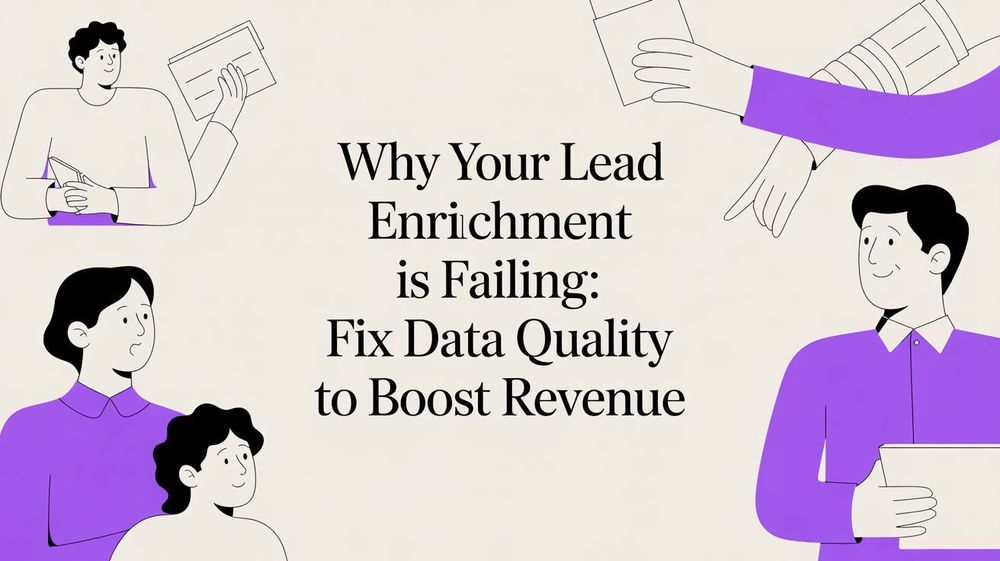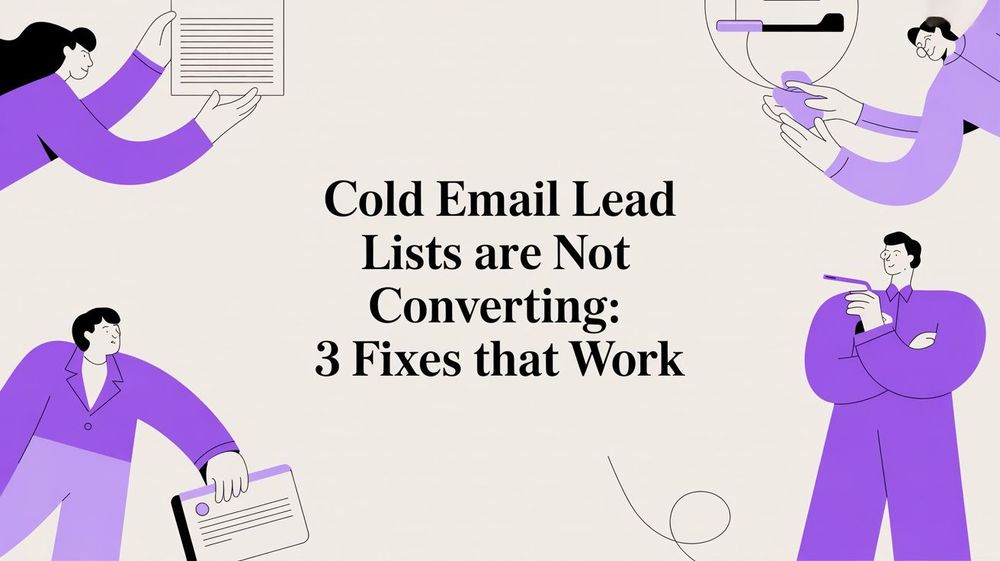In today's competitive sales and marketing environment, manual lead generation is no longer a sustainable strategy. It's a time-consuming, error-prone process that simply doesn't scale with business growth. The definitive solution is automation: building intelligent, self-sustaining systems that capture, qualify, and nurture leads 24/7. However, not all automation is created equal. Many workflows are overly complex to set up and ultimately fail to deliver tangible results or a positive return on investment.
This guide cuts through the noise. We will break down seven lead generation automation workflows that actually convert, providing the strategy, tools, and step-by-step processes you can implement immediately. These aren't theoretical concepts; they are practical, high-impact systems designed not just to collect contacts, but to transform them into paying customers. By mastering these flows, you can turn your lead generation from a manual chore into an efficient, revenue-driving machine.
To truly stop chasing leads and build a funnel that fills itself, it's crucial to understand the foundational capabilities that power these systems. You can explore essential marketing automation features to see how the right toolset makes these complex workflows manageable and effective. For many of the workflows we'll cover, the critical first step is sourcing high-quality prospect data. While traditional methods involve tedious manual research or complex coding, a modern tool like ProfileSpider streamlines this initial phase. Its one-click profile extraction empowers recruiters, sales teams, and marketers to build highly targeted lists from any website in minutes, feeding your new automated funnels with precision and saving hours of manual work.
1. Lead Scoring and Nurture Automation
Not all leads are created equal. Some are ready to buy today, while others are just beginning their research. A Lead Scoring and Nurture Automation workflow is one of the most powerful lead generation automation workflows that actually convert because it intelligently separates hot prospects from lukewarm browsers. This system assigns points to leads based on who they are (demographics) and what they do (behaviors), creating a clear hierarchy of sales-readiness.
This automated process tracks every interaction, from email opens and website visits to content downloads and pricing page views. Once a lead's score crosses a predefined threshold, the workflow automatically routes them to the sales team as a Marketing Qualified Lead (MQL). Leads that don't yet qualify are placed into a separate, automated nurture sequence designed to educate them and gently guide them toward a purchase decision.

Why This Workflow Converts
This dual-pronged approach ensures two critical outcomes:
- Sales teams focus their energy exclusively on prospects with the highest conversion potential, dramatically improving efficiency and morale.
- No lead is left behind. Instead of being discarded, lower-scoring leads receive valuable, relevant content that builds trust and keeps your brand top-of-mind until they are ready to engage.
Platforms like HubSpot and Salesforce have built entire ecosystems around this concept, proving its effectiveness at scale. By automating the sorting and initial nurturing process, you create a seamless bridge between marketing efforts and sales activities.
Actionable Takeaways
To implement this workflow effectively, start by collaborating with your sales team to define what an ideal lead looks like. From there, you can build a scoring model.
- Combine Data Points: Use a mix of demographic data (like job title, company size, industry) and behavioral data (like downloaded an ebook, visited the pricing page).
- Set Clear Thresholds: Work with sales to establish the exact score that qualifies a lead as an MQL.
- Implement Lead Decay: If a lead goes inactive for a certain period (e.g., 60 days), their score should decrease automatically to ensure the pipeline stays fresh.
- Start Small: Begin with 5-7 key scoring indicators and refine the model over time based on which leads actually close.
For those looking to build their initial lead lists with rich demographic data, a no-code tool like ProfileSpider is invaluable. With its one-click AI-powered extraction, you can capture detailed professional profiles from any website, create custom lists, and tag them based on their potential fit (e.g., "target-industry," "decision-maker"). You can then export this organized data directly into your CRM. This high-quality initial data makes your lead scoring far more accurate from day one, all while ensuring complete privacy as data is stored locally in your browser. You can find more information about how this fits into a broader strategy by exploring these marketing automation workflow examples.
2. Email Drip Campaign Sequences
An Email Drip Campaign is a series of automated emails sent to prospects over a specific period. This is one of the most fundamental lead generation automation workflows that actually convert because it delivers the right message at the right time, guiding new leads through the buyer's journey without manual intervention. Triggered by a specific action, like a newsletter signup or a content download, these sequences maintain consistent communication and build relationships at scale.
Instead of a one-off welcome message, a drip campaign nurtures interest by providing value over several touchpoints. For example, a new subscriber might receive a welcome email on day one, a case study on day three, and a special offer on day seven. This methodical approach keeps your brand top-of-mind and moves leads from initial awareness to consideration and, ultimately, to a decision.
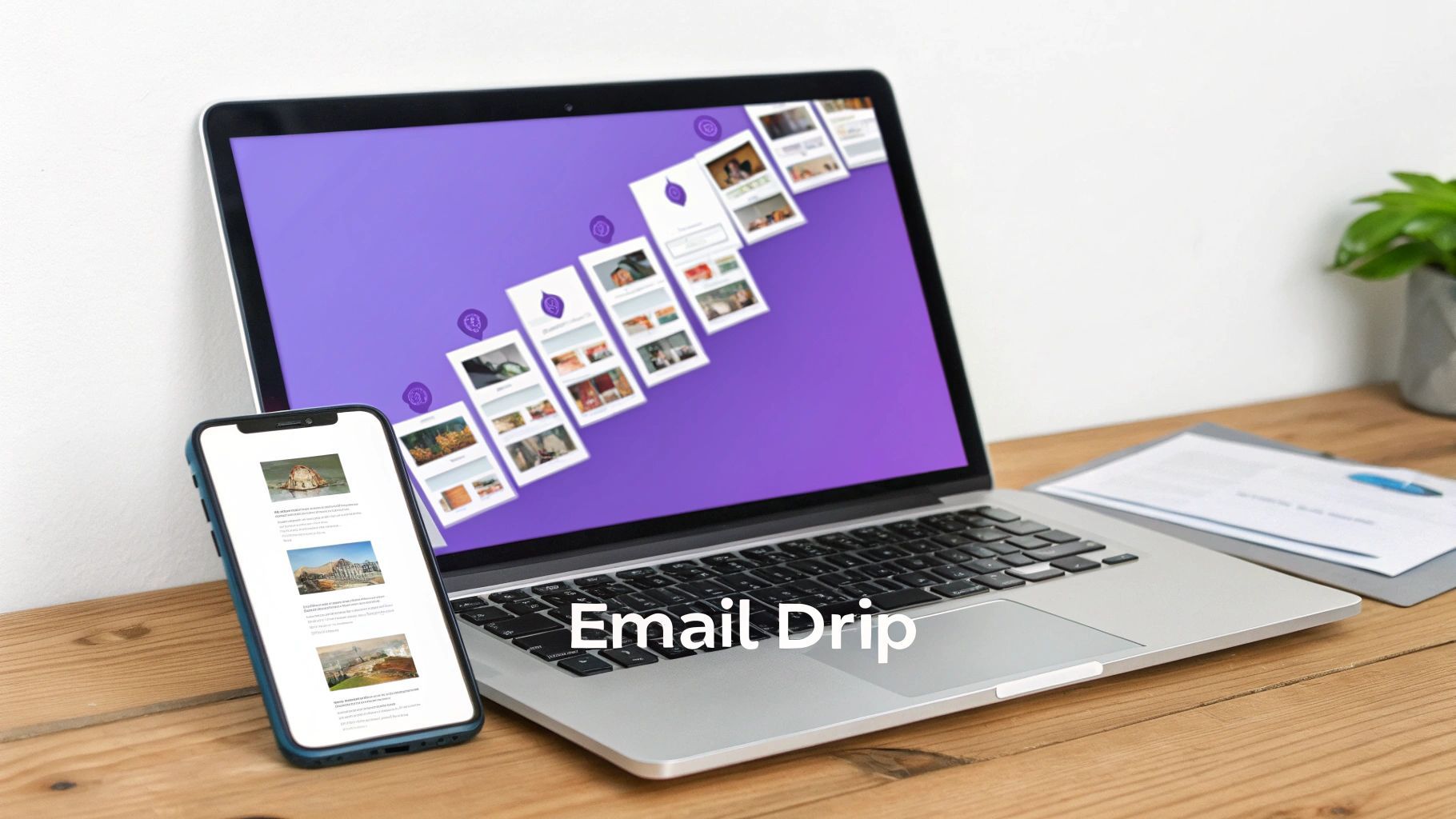
Why This Workflow Converts
Email drip sequences are highly effective because they are built on the principle of timely, relevant communication.
- They build momentum. Each email builds on the last, creating a narrative that educates the prospect and systematically overcomes objections.
- They scale personalization. By segmenting lists based on the initial trigger, you can deliver hyper-relevant content that resonates with different audience needs, making prospects feel understood rather than spammed.
Platforms like ConvertKit and ActiveCampaign have popularized this workflow by making it easy to design complex, branching sequences that adapt to user behavior. The result is a highly efficient system that nurtures leads 24/7, ensuring no opportunity slips through the cracks.
Actionable Takeaways
To build a high-converting drip sequence, focus on providing value before asking for the sale. A well-crafted campaign feels more like a helpful conversation than a marketing blast.
- Define a Clear Goal: Each sequence should have a single, primary objective, whether it's booking a demo, making a first purchase, or upgrading a plan.
- Segment Your Audience: Don't send the same drip campaign to everyone. Create different sequences for leads from different sources (e.g., webinar attendees vs. ebook downloaders).
- Map Your Content: Plan a sequence of 5-7 emails that logically guide the user. Mix educational content (blog posts, guides) with social proof (testimonials, case studies) and promotional offers.
- Set Exit Criteria: Automatically remove a lead from a sequence once they convert (e.g., make a purchase or book a meeting) to avoid sending irrelevant messages.
Of course, a powerful drip campaign starts with a high-quality email list. Instead of spending hours manually copying and pasting contact information, ProfileSpider enables you to source targeted contacts from any website with a single click. You can tag them by industry or job title, and export them directly to your email platform. This simple, no-code process ensures your automated sequences are reaching the right people from the very beginning. To dive deeper into this initial step, explore these expert tips on how to build email lists.
3. Landing Page + Form to Lead Database Automation
At the heart of most digital marketing funnels lies a simple transaction: a visitor provides their information in exchange for something of value. A Landing Page + Form to Lead Database Automation workflow is fundamental because it streamlines this critical conversion point. Instead of manually exporting form submissions and uploading them to a CRM, this workflow instantly captures, organizes, and initiates contact with every new lead.
This system connects a high-converting landing page directly to your marketing and sales software. When a user fills out a form to download an ebook, sign up for a webinar, or request a demo, their data is immediately sent to a lead database or CRM. Simultaneously, it can trigger a welcome email, add the lead to a specific list for segmentation, and even notify a sales representative of the new submission. This makes it one of the most essential lead generation automation workflows that actually convert.
Why This Workflow Converts
This workflow excels by capitalizing on the moment of peak interest.
- It ensures immediate engagement. By sending an automated confirmation or welcome email the second a lead submits their information, you reinforce their decision and deliver the promised value instantly, building trust from the first interaction.
- It eliminates costly human error and delays. Manual data entry is slow and prone to mistakes. Automation guarantees that every lead is captured accurately and no one falls through the cracks, ensuring a 100% follow-up rate.
Platforms like HubSpot, Leadpages, and Unbounce have perfected this model, enabling marketers to build and connect these funnels without writing a single line of code. The result is a seamless, professional experience for the user and a clean, organized, and actionable database for your team.
Actionable Takeaways
To maximize conversions from your landing page forms, focus on creating a frictionless user experience.
- Keep Forms Minimal: Start by asking for only the essentials, typically 3-5 fields like name, email, and company. You can use progressive profiling on subsequent forms to gather more data over time.
- Match Form Fields to Sales Needs: Ensure the data you collect aligns directly with what your sales team needs for qualification. If company size is critical, include it. If not, leave it out.
- Implement Multi-Step Forms: For longer forms, break them into two or three steps. This reduces the initial psychological friction and can significantly increase completion rates.
- Offer a Clear Value Proposition: Place a concise, powerful benefit statement directly above the form to remind users exactly what they will get by submitting their details.
To ensure your CRM is populated with high-quality, relevant data from the start, you can use ProfileSpider to gather initial prospect lists. For example, a recruiter could extract candidate profiles from a job board, or a sales professional could capture leads from a professional network. After tagging them based on an ideal customer profile, you can run targeted campaigns that direct them to your automated landing pages. Discover more about how to connect this type of data directly with your CRM by reading this guide on feeding your sales pipeline automatically. For those aiming to significantly scale their landing page efforts, explore this compelling case study on how an agency doubled traffic with automated page creation.
4. Webinar Registration to Sales Funnel Automation
Webinars are a cornerstone of modern B2B marketing, but their true power is unlocked when you automate the entire lifecycle, from sign-up to sales handoff. A Webinar Registration to Sales Funnel Automation is one of the most effective lead generation automation workflows that actually convert because it transforms a one-time event into a continuous pipeline of engaged, educated, and qualified leads. This system manages reminders, tracks participation, and triggers tailored follow-up sequences for every single registrant.
The process begins the moment a user registers. The workflow automatically sends confirmation and reminder emails leading up to the event. During the webinar, it records attendance and even engagement metrics like questions asked or polls answered. Afterward, the automation segments the audience into two primary groups: attendees and no-shows. Each group receives a distinct follow-up sequence designed to maximize conversion based on their level of engagement.
Why This Workflow Converts
This segmented approach ensures you capitalize on every registration, regardless of whether they attended the live event.
- Attendees get immediate, relevant follow-up while their interest is at its peak. This could be a thank you email with a link to the presentation slides, a special offer, or a direct prompt to book a demo.
- No-shows are re-engaged, not lost. Instead of being forgotten, they automatically receive a link to the webinar replay, giving you a second chance to capture their attention and pull them deeper into your funnel.
Platforms like GoToWebinar and HubSpot have powerful integrations that make this level of automation seamless. By treating the webinar as the start of a conversation rather than the end, you nurture every lead according to their specific journey.
Actionable Takeaways
To build a high-converting webinar funnel, focus on segmentation and timely communication. The goal is to guide registrants to the next logical step in their buyer's journey.
- Segment Your Follow-Up: Create separate email sequences for "Attendees" and "No-Shows." Attendees get a direct call-to-action, while no-shows are encouraged to watch the replay.
- Automate Reminders: Schedule a series of at least three reminder emails: one immediately upon registration, another a few days before, and a final one on the day of the event.
- Follow Up Within 24 Hours: For attendees, send a follow-up email with the presentation recording and a clear next step (e.g., "Book a Demo," "Download the Guide") within a day to capitalize on their high engagement.
- Track Replay Viewers: Treat anyone who watches the replay as a warm lead. Tag them in your CRM and add them to a long-term nurture sequence or notify your sales team.
For marketers looking to drive high-quality registrations, ProfileSpider can be instrumental. Instead of relying on broad advertising, you can identify and extract profiles of professionals in your target industry from platforms like LinkedIn, tag them as "Webinar-Prospects," and export the list to run highly targeted ad campaigns or outreach sequences inviting them to your event. This simple, one-click process ensures your registration funnel is filled with high-intent leads from the very beginning.
5. Chatbot Qualification and Lead Capture Automation
Your website is your digital storefront, but what happens when visitors arrive after hours? A Chatbot Qualification and Lead Capture Automation workflow acts as a 24/7 digital concierge, engaging prospects the moment they show interest. This is one of the most effective lead generation automation workflows that actually convert because it provides instant, interactive qualification, capturing high-intent leads that might otherwise leave your site.
These AI-powered bots guide visitors through a conversational funnel, asking key qualifying questions, providing immediate answers, and capturing contact information. Based on a visitor's responses, the chatbot can instantly identify if they are a hot prospect. It can then schedule a demo, book a meeting directly on a sales rep's calendar, or seamlessly hand off the conversation to a live agent, all without human intervention.

Why This Workflow Converts
This workflow capitalizes on peak user intent, a critical factor for conversion. Instead of forcing a high-intent visitor to fill out a form and wait for a response, it offers an immediate path to their goal.
- It reduces friction and response time, dramatically increasing the chances of converting a visitor into a qualified lead before they lose interest or go to a competitor.
- It pre-qualifies leads for sales, meaning sales representatives only engage in conversations with prospects who have already confirmed their need, budget, or authority, making every interaction more productive.
Platforms like Drift and Intercom have revolutionized B2B sales by demonstrating the power of conversational marketing. By automating the initial engagement and qualification, you create a direct and efficient channel from anonymous visitor to sales-qualified lead.
Actionable Takeaways
To build a high-converting chatbot workflow, focus on creating a natural and helpful conversation, not a robotic interrogation.
- Limit Initial Questions: Start with just 3-5 essential qualifying questions (e.g., company size, role, primary challenge) to avoid overwhelming the visitor.
- Offer an Escape Hatch: Always provide a clear option to "talk to a human" or bypass the bot. This prevents frustration and captures leads who prefer direct contact.
- Use Conversational Language: Write your bot's script to sound human and helpful. Avoid corporate jargon and overly formal phrasing.
- Provide Context in Handoffs: When a bot transfers a lead to a sales rep, ensure the full conversation transcript is included so the rep can pick up where the bot left off.
For account-based marketing (ABM) strategies, you need to know who your website visitors are. You can use a no-code tool like ProfileSpider to build rich profiles of decision-makers at your target accounts. By extracting professional details and tagging them by company, you can create a database to upload into your chatbot platform. This allows the bot to recognize visitors from target companies and initiate a personalized, high-value conversation flow from the moment they land on your site.
6. Account-Based Marketing (ABM) Personalization Workflows
Instead of casting a wide net, Account-Based Marketing (ABM) flips the traditional lead generation funnel on its head. This highly targeted approach focuses marketing and sales resources on a predefined set of high-value accounts. ABM Personalization Workflows are a cornerstone of this strategy, automating hyper-relevant, multi-channel outreach to key decision-makers within those target companies.
This workflow treats each target account as its own unique market. It uses rich data to identify the right contacts, understand their pain points, and orchestrate coordinated campaigns across email, social media, digital ads, and even direct mail. Rather than waiting for individual leads to come in, ABM automation proactively engages entire buying committees with messaging that is tailored specifically to their company's needs, industry, and challenges.
Why This Workflow Converts
ABM personalization is one of the most effective lead generation automation workflows that actually convert because it eliminates waste and maximizes relevance. Key benefits include:
- Higher Deal Value: By focusing exclusively on best-fit, high-value accounts, the average deal size naturally increases.
- Improved Sales and Marketing Alignment: Both teams collaborate from the start to define the target account list and coordinate outreach, creating a unified and more effective customer experience.
- Shorter Sales Cycles: Engaging multiple stakeholders simultaneously with personalized content helps build consensus faster and accelerates the decision-making process.
Platforms like Demandbase, 6sense, and Terminus have pioneered this data-driven approach, allowing B2B companies to move from a "one-to-many" to a "one-to-few" or even "one-to-one" marketing model. This ensures every touchpoint is meaningful and directly contributes to building a strong relationship with the account.
Actionable Takeaways
To launch an effective ABM workflow, start small and build momentum. Your initial goal is to prove the model with a tightly focused pilot program.
- Define Your Ideal Customer Profile (ICP): Work with sales to create a crystal-clear definition of your perfect target account, based on firmographics like industry, company size, revenue, and technology stack.
- Build Your Target Account List: Start with a manageable list of 50-100 accounts that perfectly match your ICP.
- Use Coordinated, Multi-Channel Touchpoints: Plan your outreach so that a prospect sees your ad on LinkedIn, receives a personalized email from a sales rep, and sees a case study relevant to their industry all within a few days.
- Measure Account-Level Engagement: Shift your metrics from individual lead scores to account-level engagement. Track how many contacts within a target account are interacting with your brand and how that engagement trends over time.
Building the contact list for your target accounts is a critical first step. Traditional methods are slow and manual. In contrast, you can use ProfileSpider to navigate to a target company’s LinkedIn page or website and instantly extract the profiles of key decision-makers with a single click. Tag these profiles with the account name (e.g., "target-acme-corp") and job function ("engineering-vp") to create organized, account-specific lists that can be exported directly into your CRM or ABM platform, providing the fuel for your personalized campaigns.
7. Lead Retargeting and Re-engagement Automation
A significant portion of your leads will inevitably go cold. They might lose budget, get busy, or simply forget about you. A Lead Retargeting and Re-engagement Automation workflow is one of the most cost-effective lead generation automation workflows that actually convert because it focuses on reviving these forgotten prospects instead of constantly paying for new ones. This system identifies inactive leads and automatically triggers targeted campaigns to bring them back into the fold.
This workflow monitors lead activity, or lack thereof, over a defined period (e.g., 60 or 90 days without an email open, click, or site visit). Once a lead is flagged as "cold," the automation initiates a multi-channel sequence designed to reignite their interest. This could involve a "we miss you" email series, targeted display ads showcasing new features, or social media ads reminding them of the value you offer.
Why This Workflow Converts
This strategy is powerful because it targets a warm, albeit dormant, audience that has already shown interest in your brand.
- Maximizes Marketing ROI: It costs far less to re-engage an existing lead than to acquire a brand new one. This workflow squeezes maximum value from your initial lead generation efforts.
- Maintains a Clean & Active List: By systematically identifying and attempting to re-engage cold leads, you also get a clear signal of who is truly uninterested, allowing you to clean your lists and improve overall deliverability and engagement metrics.
Companies like Spotify and Amazon are masters of this, using personalized "come back" offers and reminders to successfully win back lapsed users and shoppers. The automation ensures these timely nudges happen without any manual intervention.
Actionable Takeaways
To build a successful re-engagement workflow, you must define inactivity and provide genuine value to entice leads back.
- Define Your Inactivity Trigger: Set a clear rule for what constitutes a "cold" lead. A common starting point is 90 days of no engagement (no email opens, clicks, or website visits).
- Segment Your Inactive Leads: Don't treat all cold leads the same. Segment them by their original interest (e.g., the ebook they downloaded or the product they viewed) to make your re-engagement message more relevant.
- Offer New Value: Don't just say "we miss you." Offer something compelling, like an updated guide, a case study relevant to their industry, an exclusive discount, or a sneak peek at a new feature.
- Use a Multi-Touch Approach: A simple, effective sequence is a three-touchpoint approach: an initial value-driven email, a follow-up with social proof, and a final "last chance" email before marking them as inactive for good.
For re-engaging leads who may have changed roles, ProfileSpider is an essential tool. Instead of writing off an old contact, you can quickly search for their name and find their current professional profile on LinkedIn or their new company website with one click. This allows you to update their contact information in your CRM and tailor your re-engagement message to their new position, dramatically increasing your chances of reconnection. You can explore a deeper dive into these kinds of automated strategies with these marketing automation workflow examples.
7 High-Converting Lead Generation Automation Workflows — Comparison
| Workflow | Implementation Complexity 🔄 | Resource Requirements 💡 | Expected Outcomes ⭐📊 | Ideal Use Cases | Key Advantages ⚡ |
|---|---|---|---|---|---|
| Lead Scoring and Nurture Automation | High — model tuning & continual refinement 🔄🔄 | CRM + historical data, analytics, sales alignment, automation platform | Better lead quality, higher conversion and shorter cycles ⭐⭐⭐ | High-volume B2B, inbound-heavy funnels, sales-led organizations | Scales qualification, automated routing, data-driven handoffs ⚡ |
| Email Drip Campaign Sequences | Medium — content + testing effort 🔄🔄 | ESP, copy/design resources, segmentation, analytics | Improved opens/CTR and staged conversions (typical lift 30–50% open) ⭐⭐ | Onboarding, nurture journeys, cart recovery, content funnels | Low ongoing effort once built; highly scalable and cost-effective ⚡ |
| Landing Page + Form to Lead Database Automation | Medium — integration & validation work 🔄🔄 | Landing builder, form logic, CRM integration, web dev for advanced hooks | Immediate capture, improved data quality; conversion benchmarks 3–25% ⭐⭐ | Campaign-specific lead capture, gated content, event registration | Eliminates manual entry, instant routing and segmentation ⚡ |
| Webinar Registration to Sales Funnel Automation | High — production + multi-touch orchestration 🔄🔄🔄 | Webinar platform, promotion, production team, CRM workflow, follow-up content | Engaged, event-driven leads; recording reuse; conversion to SQL ~3–15% ⭐⭐ | Product demos, thought-leadership, education-driven demand gen | Live engagement yields high-intent leads and natural sales handoffs ⚡ |
| Chatbot Qualification and Lead Capture Automation | Medium–High — NLP training & maintenance 🔄🔄🔄 | Chatbot/NLP tooling, conversation design, CRM integration, monitoring | 24/7 capture, higher response rates (↑50–100%), reduced qualification time ⭐⭐ | Website qualification, after-hours capture, fast-response use cases | Instant qualification at scale, reduces sales time on initial triage ⚡ |
| Account-Based Marketing (ABM) Personalization Workflows | Very high — cross-channel orchestration & data infra 🔄🔄🔄🔄 | ABM platform, intent & account data, creative assets, sales coordination | Larger deal sizes, higher win rates, strong account-level ROI (benchmarks: ~171%) ⭐⭐⭐ | Enterprise targets, high-value accounts, strategic deals | Focused, high-ROI targeting with coordinated multi-channel touchpoints ⚡ |
| Lead Retargeting and Re-engagement Automation | Medium — segmentation and frequency controls 🔄🔄 | Ad platforms, email sequences, audience lists, creative, testing | Reactivates dormant leads (5–15% typical), cost-effective reacquisition ⭐⭐ | Lapsed customers, inactive trials, abandoned carts | Efficient reuse of existing data, shorter sales cycles and lower CPA ⚡ |
From Workflows to Wins: Making Automation Work for You
We've explored 7 lead generation automation workflows that actually convert, moving from foundational strategies like lead scoring and email drips to sophisticated systems for webinar funnels and Account-Based Marketing. Each workflow represents a powerful engine for growth, but the real magic happens when you move from understanding these concepts to implementing them with precision and strategy.
The journey from manual, often inconsistent lead generation to a streamlined, automated system can feel daunting. However, the path forward is not about boiling the ocean. It's about taking a single, strategic step. The core takeaway from these seven workflows is that automation is not a replacement for strategy; it is an amplifier of it. Your goal shouldn't be to "set it and forget it," but to "set it, measure it, and optimize it."
The Unifying Thread: Quality Data as Fuel
Across all seven examples, from the initial contact in a chatbot to a highly personalized ABM sequence, one non-negotiable requirement stands out: high-quality, targeted data. Your automation workflows are only as effective as the leads you feed into them. Sending a perfectly crafted re-engagement email to an outdated or irrelevant contact is a wasted effort.
This is where the process begins, long before a trigger is fired or an email is sent. While traditional data collection is a manual chore, modern tools like ProfileSpider are fundamental to this initial stage. By enabling one-click profile extraction from any website, you can build clean, accurate, and highly segmented lists that serve as the fuel for your automated engines. Imagine building a hyper-targeted list of conference attendees for a post-event webinar workflow, or sourcing key decision-makers for your ABM campaigns—all without manual data entry. This no-code simplicity is the foundation upon which successful automation is built.
Strategic Insight: Automation without accurate data is just a faster way to get the wrong message to the wrong person. Prioritize your data acquisition and hygiene process as the first and most critical step in building any workflow.
Actionable Next Steps: From Reading to Doing
Knowledge is only potential power. To turn these insights into tangible results, you need a clear plan of action. Here's how to get started:
- Identify Your Biggest Bottleneck: Review the seven workflows. Which one addresses the most significant point of friction in your current process? Is it qualifying inbound leads? Nurturing cold prospects? Re-engaging past contacts? Start there.
- Choose ONE Workflow to Master: Don't try to implement all seven at once. Select the one that promises the highest impact for your immediate goals. Focus on building, testing, and refining that single workflow until it consistently delivers results.
- Build Your Foundation with Quality Data: Before you build a single automation, define your ideal customer profile. Use a modern, no-code tool like ProfileSpider to create a pilot list of 50-100 highly qualified prospects. Its simple one-click extraction saves hours of work and ensures this targeted list is your perfect testbed for validating messaging and workflow logic on a small scale.
- Map Your Triggers and Actions: Visually map out your chosen workflow. What specific action will trigger the sequence? What are the exact steps (emails, delays, tasks, tags) that will follow? Be explicit.
- Measure, Analyze, and Iterate: Define your success metrics upfront. Is it open rates, reply rates, meetings booked, or demo requests? Monitor your results closely and don't be afraid to tweak your copy, timing, and logic based on real-world performance.
The Future is Automated, Personalized, and Profitable
Mastering these 7 lead generation automation workflows that actually convert is more than just a technical exercise; it's a strategic imperative. In a competitive market, speed, personalization, and efficiency are what separate leaders from the rest. By taking the manual, repetitive tasks off your team's plate, you free them up to do what humans do best: build relationships, think strategically, and close deals.
The workflows detailed in this article provide the blueprint. The tools provide the capability. Now, the opportunity is yours to build a smarter, more effective, and ultimately more profitable lead generation machine. Start small, focus on quality, and build momentum. Your future customers are waiting.

